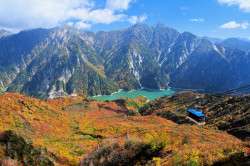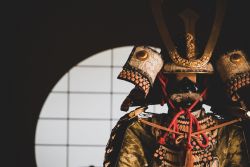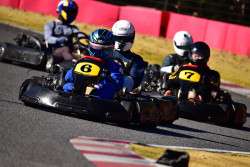
Originally published on metropolis.co.jp on October 2012

How long have you been stationed with the Naval forces in Japan?
I have been stationed in Japan since April 2011. I served 12 months as the executive officer of USS Curtis Wilbur and assumed command in April 2012.
Where were you stationed prior to Japan?
I have served all over the United States and the world and have been fortunate to visit 56 countries during my Navy career. My assignments in the U.S. have been in Norfolk, Virginia, Ingleside, Texas, San Diego and Monterrey California, Washington D.C. and Newport, Rhode Island. Most enjoyable, though have been my two previous assignments abroad with almost two years in Manama, Bahrain as an Operations Officer of the Middle East Force and one year at the Naval War College in Buenos Aires, Argentina.
What does this posting mean to you on both a personal and professional level?
Personally, I have tried to come to Japan since 1997 when selecting my second ship. I was even scheduled to a ship in Sasebo in 2006 until an orders change sent me to Texas. I love everything about seeing the world and being able to immerse myself in Japanese culture is a spectacular opportunity. My family enjoys their time here as well, with my children attending a Japanese kindergarten (Seika Yochien) and my wife spending time with various cross cultural groups here in Yokosuka.
Professionally, the opportunity to command a ship as part of the U.S. Navy’s Forward Deployed Naval Force is truly the highlight of my career. The ability to engage with partner navies through exercises and operations is perhaps my favorite part of deployed operations. I am truly honored to be selected to maintain and build bonds with all nations and, most importantly, our brethren in the JMSDF.
From a community relationship-building standpoint, what is your top priority as Commander of the USS Curtis Wilbur?
Our top priority is to continue to maintain and build on the good relationship we generally have with our hosts and neighbors. As Japanese and Americans learn more about one another, they can cooperate better and that cooperation can help in the defense of Japan. Developing close relationships and trust can help in events such as the Tohoku earthquake and tsunami, where the Navy and the JMSDF were able to work closely with the citizens of the affected areas to help ease some of their suffering.
How many military personnel do you oversee in Yokosuka and Japan in general?
Overall in Japan there are approximately 6,800 sailors (including officers & enlisted) assigned to shore duty. There are about 11,600 sailors assigned to afloat units operating out of Japan.
Have you managed to see much of Japan?
I have been very lucky to see many parts of Japan through both professional and personal travel. Our ship has visited Okinawa and Sasebo and we have spent time with the officers and crew of our Japanese sister ship, Kirishima. I have visited Nagoya, Kyoto and Osaka to enjoy the culture and sightseeing. I have also spent time at Mt. Fuji during summer and winter. I went sledding and skiing with my family and am looking forward to going again this winter. This summer, I climbed Mt. Fuji twice: once on a single day trip with my crew and the second time with my wife for an overnight to see the sunrise from the top.
What’s your favorite thing about being in Japan?
There are many aspects that I love about living in Japan. The people and friendliness that my family and I are met with throughout Japan is probably my favorite part of being here.
How do you get “off the base” both physically and spiritually?
I have adapted well to driving in Japan and typically depart the base in our car with the aid of various GPS devices and maps. Despite this electronic assistance, I regularly will ask for help or find myself in different places than I expected. However, in general, I have accomplished a significant amount of travel by car to Kyoto and Osaka, as well as Mt Fuji. My favorite place thus far has been the areas of Mt. Fuji and Hakone. Its proximity to Yokosuka and multitude of things to do from hot springs to winter activities to climbing and sightseeing is spectacular. This past weekend, I traveled to Mt. Fuji with my three- and four-year-old children to climb the mountain. While we only climbed to the old 5th and 6th stations, the experiences for the kids will be memories for a lifetime.
Do you think the servicemen and women on the base manage to make the most of being here?
I believe those sailors who desire to get to know Japan and visit areas in and around Yokosuka, Yokohama and Tokyo use their time effectively. I am often amazed at the different festivals and locations that my sailors visit during their off time. Additionally, there are many sailors who take advantage of the offerings from the base to see Japan and enjoy outdoor activities while stationed here.
What’s one thing you would encourage them to do?
I encourage them all to find places and things to do, get on trains and go. I encourage them to get to know the areas and people of Japan to immerse themselves in the culture outside the immediate vicinity of the base.
What is the biggest problem for people trying to get off the base and out and about in Tokyo?
The biggest problem for sailors, myself included, is a lack of understanding the Japanese language. While many people are willing to help acclimate to an area or assist for directions and advice, the language barrier is difficult for others.
What types of big community activities that are open to the public happen on or around the base throughout the year?
In April the base holds a Cherry Blossom Festival in which the base is open to local residents who may come aboard, enjoy bands and games, American food (lots of different kinds of food stands) and ship visits (usually one or more ships forward deployed to Yokosuka are open for general visiting). Generally, in August of each year, the base and the City of Yokosuka collaborate in an open base event, with ship visits (often times both USN and Japan Maritime Self Defense Force ships), games, food stands, bands and a fireworks display at night. Usually in October, the base participates in the Yokosuka Omikoshi Parade.
Are there other community activities that the Navy participates in?
The Navy participates in several disaster response drills with the City of Yokosuka, Kanagawa Prefectural Government and the Tokyo Metropolitan Government each year. Several times a year, the City and base cooperate in conducting a walking tour of historic sites on Yokosuka base for Japanese citizens.







